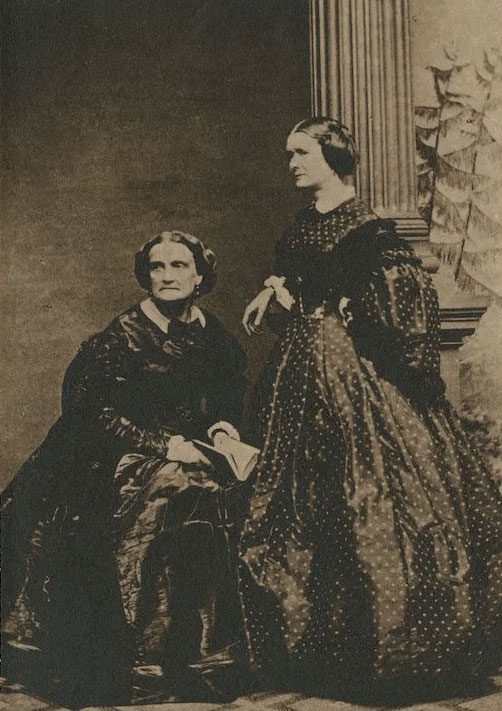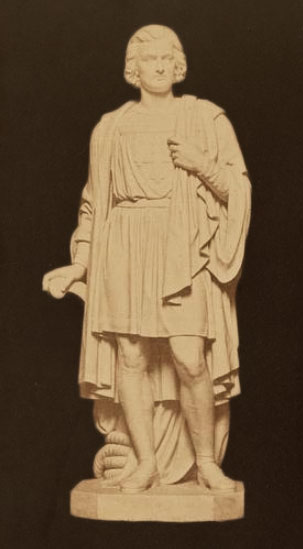Pioneering Gay Sculptor Emma Stebbins and Her Columbus Statue Targeted for Takedown in Brooklyn
Supporters of pioneering gay sculptor Emma Stebbins pushed back against a campaign to take down her celebrated 162-year-old Columbus statue in downtown Brooklyn by activists who complain the openly gay artist of the 1800s wasn’t “woke” enough.
“Emma Stebbins may soon be the latest victim of the irrational frenzy that seeks to wipe away all memory of Christopher Columbus,” said Angelo Vivolo, president of the Columbus Heritage Coalition.
Born in Manhattan, Stebbins (below, right) opened an artist’s studio in Rome where she lived with her partner, renowned actress Charlotte Cushman. Her interpretation of Columbus made her the first woman to create public artwork for New York City. She envisaged a Columbus at midnight standing upon the deck with his hand on the rudder-post, “piercing the darkness with his eye of faith,” waiting for the dawn.

“One cannot help but feel that Stebbins expressed some of her own spirit in her representation of the defiant Columbus,” observed Dr. John La Corte, the president of the Italian Historical Society of America. “Standing up to the judgment and criticism of the entrenched views of her time, we can imagine her identifying with the visage of strength and determination she so artfully places on the face of the young Columbus,” he said.
Brooklyn Community Board 2 sided with the anti-Stebbins activists last week in an advisory vote that would carry away the statue and have it closeted to an unknown location.
A group called Take Down Columbus sought the board’s non-binding resolution. The publicly stated mission of Take Down Columbus is to “tear down” and “eliminate” statues such as Emma Stebbins’ Columbus regardless of context and history. Members have publicly stated they will work on dislodging all Columbus statues in New York City “by whatever way we have to do it.”
But the defense of Stebbins and her work reflects a spectrum of viewpoints supporting her statue of Columbus, which was welcomed to its niche near Brooklyn Borough Hall fifty years ago through the efforts of La Corte’s father, a community activist.
Rafael Ortiz, an author of several books about Columbus and his impact on Hispanic Americans, appealed to the board to consider the impact of their actions on other cultures, especially the Hispanic community. He noted that Columbus sailed for Spain, which transmitted its language and culture over the centuries. Ortiz said, “We know that the Italian-born explorer’s legacy has been twisted and misrepresented into a biased and hateful view of Hispanic and Latino cultures and that of the Spanish, who were the first European settlers in the new world. I’m here to ask you to help us stop the systematic racism against the Italian American and the Hispanic communities.”
He noted that Columbus sailed for Spain, which transmitted its language and culture over the centuries. Ortiz said, “We know that the Italian-born explorer’s legacy has been twisted and misrepresented into a biased and hateful view of Hispanic and Latino cultures and that of the Spanish, who were the first European settlers in the new world. I’m here to ask you to help us stop the systematic racism against the Italian American and the Hispanic communities.”
Ortiz added: “I kindly ask those who persist in removing Columbus’ statues Today: Please stop. Rather than split us apart, join us instead was we celebrate the true meaning of Christopher Columbus and our Hispanic culture, traditions, and diversity.”
John Fratta, chairman of the New York State Commission on Social Justice, explained how Italian immigrants of the 19th and early 20th centuries turned to Christopher Columbus as a symbol of pride in the face of prejudice When anti-Italian hatred erupted in cities across the nation. “Italians in America needed a hero,” he said. “They looked to Christopher Columbus. Many of the statutes of Columbus were funded by impoverished Italian immigrants. They gave their pennies, nickels, and dimes to support design and construction.”
Prejudice against Italian Americans continues to this day, said Fratta. He urged Community Board 2 to “reverse course, rescind your action that is hurtful to your Italian American neighbors. Please work with us to drop the hate and seek the truth so that together we can build up more statues and not tear them down.”
Members of the general public also appealed to the board to reexamine its advisory opinion.
Jerome Krase, wrote: “Better to use the statue to teach than remove it.”
One of the speakers, Frank Lorenzo, said, “For the sake of cultural pluralism, for the sake of diversity and inclusion, please keep the monument in its place. You can’t build bridges by removing a cultural symbol. This is an immigrant symbol, it’s an Italian American symbol, and it’s a Catholic symbol.”
Another speaker, of multiracial background, said that her grandfather was African American. She noted that older generations of Americans revere Columbus. “I look white,” she said. “My grandfather was black. He loved Christopher Columbus. He loved that history. I know he would be so upset about this. We need to consider that there is an older generation that has revered this man for a long time.”
Another activist identified as Concerned Citizen wrote: “The statue merely memorializes one figure who nobody can deny played a part in our history. History & historical figures should not be torn down.”
“A whole generation already has been sullied by the likes of so many Columbus detractors,” wrote Lou Gallo. “Particularly Howard Zinn, the infamous “historian,” avowed Marxist and manipulative progenitor down rightly responsible for the misinformation, disinformation, faulty interpretations and translations, non-sequiturs, and textual corruptions about the legacy of Columbus. “
“It is quite sad!” wrote Xiao Luobo. “Never mind if he really discovered America before anybody else. It is still part of the American and Italo-American culture.”

